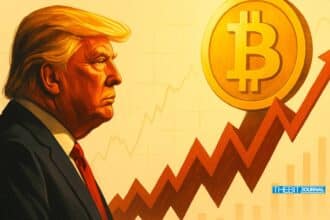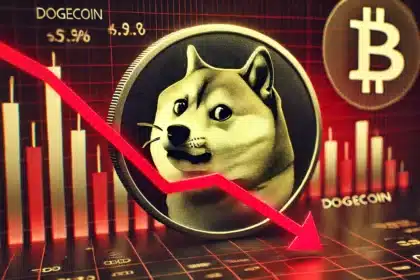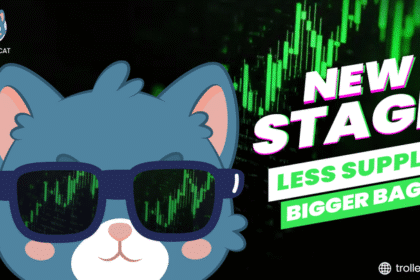Whale activity surged across major cryptos this week and large transfers dominated the headlines. On May 14, two unknown wallets each reportedly sent 498 BTC, approximately $51.4M to Coinbase, total $102.8M in Bitcoin.
The following day, another whale reportedly moved 24,496 ETH (≈$63.8M) from unknown wallet into Ceffu (CeFi). On May 11, nearly 930,000 SOL (~$159.7M) was transferred between unknown addresses. These and other big moves below coincide with recent price actions and volatility.
Bitcoin Whale Accumulation is Bullish
On-chain data shows major Bitcoin holders are buying. Santiment reports 10–10,000 BTC whale-tier wallets added +83,100 BTC in the last 30 days. Santiment noted after the brief sell-off, when prices topped $97K earlier this May, whales started buying again. On May 14, a single wallet reportedly received 5,000 BTC at 10:30 UTC, likely an accumulation.
Smaller retail holders under 0.1 BTC were selling during the rally. Santiment says this divergence of whales buying while “shrimps” sell sets up a rally to $110K all-time high, especially with global macro tailwinds.
This crypto whale demand is draining supply from exchanges. By May 14, Bitcoin on exchanges was reportedly down to 2.30 million BTC, from 2.50 million at April start. Crypto researcher Miles Deutscher noted whale withdrawals into private wallets have caused this “supply squeeze”, removing selling pressure and supporting prices. Analysts say when exchange reserves are depleted, if demand holds, it’s often bullish if whales prefer to hold rather than sell.

Key Crypto Whale Transfers (May 11–16, 2025)
| Date | Asset | Quantity | Approx. Value | From | To |
| May 11, 2025 | SOL | 929,994 SOL | ~$159.7 M | Unknown wallet | Unknown wallet |
| May 14, 2025 | BTC | 498 BTC | ~$51.4 M | Unknown wallet | Coinbase exchange |
| May 16, 2025 | ETH | 24,496 ETH | ~$63.8 M | Unknown wallet | Ceffu (CeFi) |
| May 16, 2025 | LINK | 200,000 LINK | ~$5.6 M* | Whale wallet | Binance exchange |
| May 16, 2025 | XRP | 50,000,000 XRP | ~$136.0 M* | Unknown wallet | Unknown wallet |
| May 2025 | SHIB | 6.42 trillion | ~$181 M† | Multiple (whales) | Exchanges (net inflow) |
| May 2025 | DOGE | 1,000,000,000 | ~$230 M† | Whales (100M–1B) | Whales (accumulated) |
Ethereum and Major Altcoin Whale Activity
Ether whales were active too. The 24,496 ETH movement on May 16 was just one example. Santiment’s mid-May analysis showed a 3,200 ETH dump by a major holder at 13:00 UTC on May 14, which coincided with a short-term ETH price dip.
But overall, big holders were bullish: another wallet reportedly bought 3,000 ETH (≈$5.5M) on May 2, a revived holder after years, although outside this week’s window. In the May 11-16 window itself, on-chain data showed large inflows into staking and Ceffu, this could mean whales might be shifting strategies (e.g. capitalizing on CeFi yields).
Other top altcoins saw whale activity. In Solana (SOL), one whale transferred 929,994 SOL (~$159.7M) on May 11, one of the largest single crypto transfers of the week. Chainlink (LINK) also saw 200,000 LINK (≈$5.6M) moved to Binance on May 16, possibly to provide liquidity.
Among decentralized ledgers, whale interest hit BNB and XRP as well. For example, on May 16 50 million XRP was reportedly moved between unknown wallets (value ≈$136M), indicating that big holders might be repositioning. CryptoQuant data also shows Binance whales reducing sell side Bitcoin pressure in early May, its “Exchange Whale Ratio” fell, indicating that big BNB/BTC holders were holding steady rather than dumping.
Meme Coin Whales Spark Frenzy
Meme-coin markets went wild with whale speculation. Shiba Inu (SHIB) whales loaded up big time. According to IntoTheBlock data, SHIB whale net inflows went from 238.9 billion to 6.42 trillion tokens in a few days (a ~6050% increase), SHIB price went up ~11%. This means institutional and big holders are buying SHIB, and short term is bullish.
Dogecoin was not left out. On May 15-16, blockchain expert Ali Martinez (@ali_charts) tweeted a Santiment chart showing whales (holding 100M-1B DOGE each) added over 1 billion DOGE in the last 30 days. This accumulation coincided with a 45% DOGE price increase to ~$0.250 on May 8. Dogecoin has since cooled but analysts say this whale activity was the main driver of the meme coin’s May high.

In the Solana meme space, PEPE whales were busy. Earlier in May, a whale scooped 500 billion PEPE (~$4.4M) and now holds 2 trillion total, helping to fuel the rally. Meanwhile, the rising Dogwifhat (WIF) token showed early adopters taking profit. On May 15, Bitrue’s analysis reported that “smart money” (whale) holdings of WIF fell from ~24.0M to ~23.5M tokens as exchange supply rose to 57.2%, meaning some whales started selling after a 335% move from April lows. Technical indicators (e.g., RSI >80 on WIF) suggest a short-term pullback after this whale selling.
Market Impact: Volatility, Volume, Liquidity
The crypto whale transfers had real market effects. On May 14-15 as Bitcoin whales dumped hundreds of BTC into exchanges, BTC dropped from $104K to $103K. That same day saw a surge in trading activity: Santiment noted 18% 24h volume of BTC/USDT on Binance (25,000 BTC traded) by May 14 afternoon as whales were active. Even quiet tokens lit up, LINK’s whale inflow preceded an 8% price gain that day and Solana’s whale moves kept SOL at $174.
But these inflows/outflows also drained liquidity from the market. 930,000 SOL moved at once, for example, and temporarily emptied SOL liquidity pools on exchanges. Large meme coin buys pump volume, DOGE’s active buying pushed it up 10% on May 15 but whales selling afterwards can create retracements.
Santiment’s data shows that while whales held tight on BTC in May, the smallest holders were reducing exposure, a classic sign of diverging conviction. Traders saw whipsaws: sharp intra-day moves whenever crypto whales moved millions of dollars in seconds, feeding both volatility and fear of broader sell pressure.
Expert Commentary & Analysis
Santiment (May 12–15): On May 12, Santiment saw Bitcoin whales and “sharks” (10–10k BTC wallets) add tens of thousands of BTC to their holdings as retail (≤0.1 BTC) holders sold. They noted this heavy accumulation could be a precursor to a break above Bitcoin’s ATH if buy-side appetite holds.
On May 15, Santiment emphasized the importance of whale tracking. They pointed out a 5,000 BTC inflow at 10:30 UTC on May 14 as bullish, and a 3,200 ETH outflow at 13:00 UTC that day as ETH price dipped. Traders are advised to use these signals as whale wallet inflows often precede rally breaks, while mass dumps could signal short-term tops.
CryptoQuant (May 11): CryptoQuant data shows Bitcoin’s Exchange Whale Ratio (the percentage of whale-held BTC on exchanges) has decreased in 2025. In early May, CryptoQuant wrote that Bitcoin whales are mostly in profit and accumulating again, which aligns with Santiment’s view that top addresses expect higher prices.
Lookonchain: Lookonchain reported on large PEPE buys: on May 8 a whale bought 500B PEPE (~$4.4M) and now holds 2T PEPE. Binance Square called this a bullish sign for meme coins like PEPE. Lookonchain also noted smaller whales buying newly listed tokens (e.g. FET) in early May.
Miles Deutscher (Crypto Market Strategist): On May 14, Deutscher posted that “whales have been actively withdrawing BTC from exchanges”. This downward shift in exchange reserves is a supply-side constraint. With less BTC to trade, the chance of price up increases in his view. This aligns with broader market optimism, tech stocks rose in mid-May (e.g. MicroStrategy) and US-China trade tensions eased may also boost crypto risk appetite.

Large on-chain transfers and accumulation signals from analytics firms showed a bullish tone even as these moves caused short term volatility. Retail investors and traders took note: the spike in whale activity was a warning sign (sell offs) and a bullish sign (less supply on exchanges).
Conclusion: Whale Activity Causes Mid-May Crypto Chaos
Mid-May 2025 was all about crypto whales across Bitcoin, Ethereum, Solana, and top meme coins. From $100M+ BTC transfers to multi-billion SHIB accumulations, whales are back in control, causing liquidity shifts, price shocks and volatility across major markets.
Data from Santiment, Whale Alert and IntoTheBlock showed large holders buying the dips, rotating funds between CeFi platforms and selling select altcoins like WIF after parabolic moves. The huge divergence between whale accumulation and retail selling, especially in Bitcoin, suggests strategic positioning for new all time highs.
For traders and analysts, whale flows are important in crypto markets. Whether it’s 1B DOGE added or 24,000 ETH moved to a custody platform, these moves can change sentiment and structure. Going forward, if whale wallets continue to absorb supply and exchange reserves shrink, the overall setup could be bullish
FAQs
What is a “whale” in crypto?
A whale is an entity (often a fund or individual) that holds a lot of cryptocurrency (1,000+ BTC or equivalent). Their trades move the market.
Why do we track crypto whale transactions?
Big transfers often precede big price moves. Whale buys are bullish, massive sells are bearish. Analytics firms like Whale Alert, Arkham and Santiment scan blockchains for these moves.
How does a whale’s movement affect liquidity?
When crypto whales withdraw coins from exchanges or hoard them in private wallets, they reduce the liquid supply. This can tighten the market and push prices up if demand holds. When whales dump coins into exchanges, liquidity increases and can push prices down.
Are these whale transactions “insider trading”?
On-chain transactions are public, so not illegal insider trading. But crypto whales do have market impact. Observers use these signals for trading strategies, but they don’t have private information, just big balance sheets.
Glossary
Whale: A crypto holder with very large reserves (e.g. 1,000+ BTC).
On-chain: Activity on the blockchain. On-chain data includes transfers, wallet balances, smart-contract calls, etc.
Ceffu (Centralized Finance): A centralized service for crypto (exchanges, custodial platforms). Funds moved into CeFi are essentially moving to an exchange or similar.
Exchange Inflow/Outflow: Inflow = assets deposited into an exchange; outflow = assets withdrawn. Big inflows mean selling pressure; big outflows mean accumulation.
RSI (Relative Strength Index): A technical indicator of market overbought/oversold (above 70 is often “overbought”).
HODL: Slang for holding cryptocurrency long-term (from a misspelling of “hold”).
Liquidity: The ease of buying/selling an asset without big price impact. High liquidity means you can trade fast at stable prices.
Sources





























